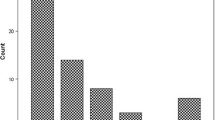Summary
Background
The objective of the study was to gather information about elderly major trauma patients admitted to one particular Slovenian trauma centre in Celje and examine this group of polytrauma patients, specifically with respect to mechanisms of injury, injury severity and distribution of injuries. Further on, to identify morbidity and mortality rates and compare these to the younger population and, finally, to determine the factors that have the most impact on treatment results.
Methods
The study gathered and evaluated data of 532 patients included in the Trauma Register DGU® of the German Trauma Society (TR-DGU) during a 10-year period and two distinct groups of patients were established, separated on account of age as older or younger than 65 years. The differences between these two groups were analyzed with respect to demographics, comorbidities, preclinical management, injury patterns, relevant clinical and laboratory findings. Furthermore, differences between deceased and surviving elderly patients were also analyzed.
Results
The majority of elderly patients suffered from a blunt mechanism of trauma (96.6%) and of these simple falls represented 47.9% within this injury mechanism. There were two body regions, which were most frequently represented, namely head and thorax injuries, accounting for 54.7% each. Complications were more frequent among the elderly, with sepsis being present in 29.9% and multiple organ failure (MOF) in 19.7% of cases. Cardiovascular failure was also high in both the elderly and young, accounting for 45.3% of the elderly and 31.3% of the younger population. The in-hospital mortality rate for the elderly group was 25.6% and was significantly higher compared to the younger counterparts (14.7%). Low fall mechanism of injury, coma and the new injury severity score (NISS) were statistically important factors for the mortality of seriously injured elderly patients during the acute phase of treatment.
Conclusions
Despite advances in care, morbidity and mortality in elderly patients after major trauma remains considerably higher than in younger populations with head injuries accounting for the majority of fatalities. The elderly patient population in this study mostly suffered from blunt mechanisms of injury, with simple falls representing a high proportion of injury mechanisms. Generally, the injury severity scale (ISS) in the elderly is not statistically higher than with the younger population. Likewise, the distribution of injuries according to body regions is also similar; however, the elderly are more prone to complications (e. g. sepsis and MOF), which is likely due to a lower physiological reserves.




Similar content being viewed by others
References
Mortality and life expectancy statistics. http://ec.europa.eu/eurostat/statistics-explained/index.php/Mortality_and_life_expectancy_statistics. Accessed: 22 Nov 2016
Adams SD, Cotton BA, McGuire MF, et al. Unique pattern of complications in elderly trauma patients at a level I trauma center. J Trauma. 2012;72:112–8.
Tornetta P, Mostafavi H, Riina J. Morbidity, mortality in elderly trauma patients. J Trauma. 1999;46:702–6.
Battistella FD, Din AM, Perez L. Trauma patients 75 years and older: long term follow-up results justify aggressive management. J Trauma. 1998;44:618–23.
Calland JF, Ingraham AM, Martin N, et al. Evaluation and management of geriatric trauma: an Eastern Association for the Surgery of Trauma practice management guideline. J Trauma Acute Care Surg. 2012;73:345–50.
Traumaregister DGU. http://www.traumaregister-dgu.de/de/ueber_uns.html. Accessed: 22 Nov 2016
Pape HC, Lefering R, Butcher N, et al. The definition of polytrauma revisited: an international consensus process and proposal of the new “Berlin definition”. J Trauma Acute Care Surg. 2014;77(5):780–6.
Perdue PW, Watts DD, Kaufmann CR, et al. Differences in mortality between elderly and younger adult trauma patients: geriatric status increases risk of delayed death. J Trauma. 1998;45(4):805–10.
Broos PLO, D’Hore A, Vanderschot P, et al. Multiple trauma in elderly patients. Factors influencing outcome: importance of aggressive care. Injury. 1993;24:365–8.
Hildebrand F, Pape HC, Horst K, et al. Impact of age on the clinical outcomes of major trauma. Eur J Trauma Emerg Surg. 2016;42(3):317–32.
Bala M, Willner D, Klauzni D, et al. Pre-hospital and admission parameters predict in-hospital mortality among patients 60 years and older following severe trauma. Scand J Trauma Resusc Emerg Med. 2013;21(1):91.
Jacobs DG, Plaisier BR, Barie PS, et al. Practice management guidelines for geriatric trauma: the EAST Practice Management Guidelines Work Group. J Trauma. 2003;54(2):391–416.
Strnad M, Borovnik Lesjak V, Vujanovic V, et al. Predictors of mortality in patients with isolated severe traumatic brain injury. Wien Klin Wochenschr. 2016; doi:10.1007/s00508-016-0974-0.
Van der Sluis CK, Klasen HJ, Eisma WH, ten Duis HJ. Major trauma in young and old: What is the difference? J Trauma. 1996;40:78–82.
Scalea TM, Simon HM, Duncan AO, et al. Geriatric blunt multiple trauma: improved survival with early invasive monitoring. J Trauma. 1990;30:129–36.
Heffermann DS, Inaba K, Arbabi S, et al. Sympathetic hyperactivity after traumatic brain injury and the role of betablocker therapy. J Trauma. 2010;69(6):1602–9.
Author information
Authors and Affiliations
Corresponding author
Ethics declarations
Conflict of interest
S. Kocuvan, D. Brilej, D. Stropnik, R. Lefering and R. Komadina declare that they have no competing interests.
Ethical standards
For this type of the study informed consent is not required. The study was reviewed by the appropriate ethics committee. Details that might disclose the identity of the patients included are omitted.
Rights and permissions
About this article
Cite this article
Kocuvan, S., Brilej, D., Stropnik, D. et al. Evaluation of major trauma in elderly patients – a single trauma center analysis. Wien Klin Wochenschr 128 (Suppl 7), 535–542 (2016). https://doi.org/10.1007/s00508-016-1140-4
Received:
Accepted:
Published:
Issue Date:
DOI: https://doi.org/10.1007/s00508-016-1140-4




